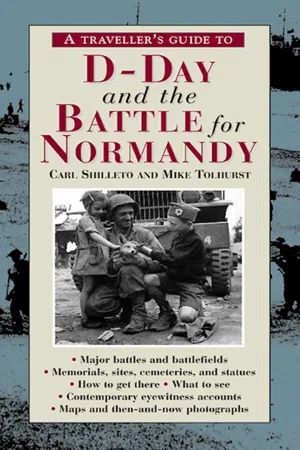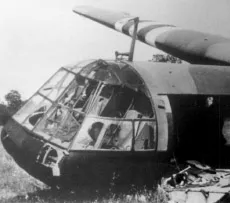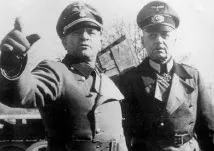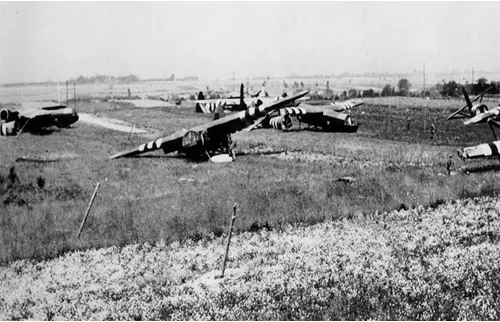![]()
1
THE FLIGHT OF PEGASUS
THROUGHOUT THE NIGHT OF JUNE 5TH, 1944, over a thousand Allied bombers pounded the German defenses between Cherbourg and the mouth of the River Dives. Lancaster, Halifax, and Mosquito bombers transformed the lush Norman countryside into a lunar landscape. Shortly after midnight, amid the confusion and spectacle, three Horsa gliders crash-landed in a narrow triangular field that lay next to a swing bridge over the Caen Canal at Bénouville. Three assault platoons, commanded by Major John Howard of the 2nd Battalion, Oxfordshire & Buckinghamshire Light Infantry, stormed the bridge to overpower the German garrison in a coup-de-main operation.
As gunfire echoed around the bridge, the German defenders were caught by surprise.
A Horsa glider of the type that landed Major
Howard and his men near Bénouville. A Very light, fired by a German sentry, revealed camouflaged troops with blackened faces charging toward the bridge. Lieutenant Brotheridge stormed across the bridge with his platoon in full battle cry. The brilliant glare of the flare also revealed the sentry’s position. Brotheridge cut him down with a sharp burst of fire from his Sten gun. The Germans returned fire. Within seconds Brotheridge, too, was mortally wounded – the first British soldier to spill his blood on French soil in the Normandy invasion.
As the battle raged, another British attack was launched on the bridge over the River Orne. Within ten minutes both bridges had been captured and the troops began digging in and setting up a defense perimeter. Their orders were to await reinforcement from the rest of the 6th Airborne Division, which would soon be landing in and around the drop zones east of the River Orne. Also arriving soon would be the inevitable counter-attack by the Germans.
It was imperative that these two bridges remained intact and in British hands. If this could be achieved then the advancing Allied armies, already aboard their ships and nearing the Normandy coast, would better be able to establish and expand their own bridgehead after landing on the beaches at daybreak. The 6th Airborne Division area of operations would act as a pivot from which the Allied forces could sweep their way around from the Cotentin Peninsula, across the French countryside, toward the Seine and Paris and, ultimately, Hitler’s Third Reich.
The Germans had been caught completely by surprise, not least the Bénouville garrison commander, Major Schmidt, who had decided to spend the evening in the nearby village of Ranville with his girlfriend. As commander of the garrison whose task it was to defend the bridges, Schmidt had not even put the demolition charges in place beneath the bridges that evening. Such nonchalance was evident straight up the German chain of command. Even Rommel, who had returned to Germany to try to persuade Hitler to release two more panzer divisions along his front, decided to combine his trip with a visit to his wife who was to celebrate her birthday on June 6th. Such were the conditions caused by the unsettled; no one, least of all the troops on the ground, expected an attack.
Major General “Windy” Gale, divisional commander of the British 6th Airborne, had several other tasks to complete before dawn, not least of which was silencing the heavily fortified German coastal battery at Merville. Despite a raid by a hundred Lancasters dropping 4,000-pound bombs, the guns of the battery were still undamaged beneath their massive reinforced concrete casemates. The task of destroying the guns was assigned to Lieutenant Colonel Terrance Otway, who would lead the men of the 9th Parachute Battalion (Para Bn) on one of the most daring raids of the whole invasion. Despite the loss of their supplies and heavy equipment, and with over three-quarters of his paratroopers still missing after a disastrously scattered drop, Otway decided to attack the battery with his meager force.
EYEWITNESS
In the Parachute Regiment, giving up is not an option. Lieutenant Colonel Otway, commander, 9th Para Bn
Otway’s command made its way through the darkened countryside to the battery’s perimeter wire. Here they waited tensely for the arrival of three gliders, due to land within the grounds of the coastal battery. The surprise arrival of the gliders, loaded with combat troops, was expected to create panic and confusion among the 130-strong German garrison; Otway would then launch his assault across the barbed wire entanglements and minefields of the fortified perimeter defenses.
As the time of the attack approached, only two gliders could be seen circling above the battery (one having lost its tow shortly after take-off), but the star shells – which the ground troops would use to illuminate the area for the glider pilots – had been lost in the drop. Under fire from German anti–aircraft guns, one of the glider pilots mistook a nearby village for the battery and headed off in the wrong direction. The second glider headed for the battery but was caught in crossfire from German anti-aircraft guns, which caused the glider to overshoot its landing zone into a nearby orchard.
A Horsa glider of the 6th Airborne Division. With Horsas, it was sometimes difficult to distinguish between a landing and a crash.
Otway decided to waste no more time and launched his attack. Two gaps were blown in the barbed wire with Bangalore torpedoes and his men charged through. In the confusion, many of the men ran over the uncleared minefield with the inevitable horrific results. Hand-to-hand fighting ensued and chaos and confusion seemed to reign. At this point, however, the months of hard training gave the attackers the edge and the German garrison was finally forced to surrender. After spiking the guns (which happened to be 100mm field guns and not the 150mm guns that had been predicted by Intelligence), Otway gave the order to withdraw. Only about 80 of the 150 men who had begun the assault were capable of walking out of the area with him. The rest lay dead or wounded.
Elsewhere, on the eastern flank of the 6th Airborne Division, the extent of the scattered parachute drops was becoming apparent. Many paratroopers had landed far from their designated drop zone and some of the least fortunate had landed in the flooded waters of the Dives Valley. Overburdened by their heavy equipment, which weighed in excess of thirty-five kilograms (eighty pounds), some subsequently drowned in the cold, dark waters of the river.
EYEWITNESS
I found I was oscillating badly when my chute opened, rigging lines twisted as well. Remembering the drill, I kicked like mad and pulled down hard on my front lift webs. I thought I was reasonably in control, when splash, I’d landed in water! It was pitch black, I was flat on my back, being dragged by my canopy in water a foot or so deep. Struggling to release my parachute harness, and trying to keep my head above water, I lost my Sten gun. After freeing myself of the parachute I searched in vain for my gun. Getting accustomed to the light I waded to dry land. Lots of trees, so I realized that I was nowhere near the dropping zone allocated to 3rd Parachute Brigade H. Q. Company. I had no radio, no gun, no small pack, soaked to the skin, no idea which way I should go, but I did have eight Sten gun magazines in my pouches! Signaller David “Dai” King, 53rd
Airlanding Light Regiment, Royal Artillery
Spread over an area in excess of 50 square miles, several groups made up from men of various regiments and battalions, formed together to complete the other primary tasks essential
Movie idol Richard Todd, a
former Lieutenant in the 7th
Parachute Battalion. to the success of the landings. As the 3rd Parachute Brigade headquarters were being set up on the high ground near Le Mesnil, the 5th Parachute Brigade began to establish its own headquarters in Ranville. From Ranville, the southern part of a ridge that ran in a semi-circle from the village of Sallenelles through Bréville and Le Mesnil toward Colombelles, would be taken and defended. Here reinforcements would assemble, ready to assist the gliderborne troops at the bridges over the River Orne and the Caen Canal. The bridge over the Ornewas later renamed Pegasus Bridge in honor of the 6th Airborne Division; the bridge over the Caen Canal was renamed Horsa Bridge after the type of glider used in the landings.
The 7th Para Bn, (which included a young officer, Richard Todd, an actor who had put his career on hold to join the Red Berets), had been reduced to less than a quarter of its strength as a result of the scattered drop. Without pause, the unit’s commanding officer, Lieutenant Colonel Pine–Coffin, gave the order to move off to their objective, Bénouville, where they were to relieve Major Howard’s men on the bridges.
Colombelles was taken and held but at the cost of numerous casualties. Despite this, the airborne troops continued to fight tenaciously and held their ground even after the seaborne forces and additional airborne reinforcements arrived later in the day.
EYEWITNESS
“A" company at Bénouville, with all its officers killed or wounded, was to hold out for seventeen hours, even though reduced to a strength of less than twenty. From time to time we could hear an officer's voice rallying his troops with shouts of encouragement. We did not realize until later that he was lying wounded by the window of a house in the village, with one leg blown away. Lieutenant Richard Todd, 7th Para Bn
The 6th Airborne Division was also under orders to delay any German advance or counter-attack from the east. To achieve this, five bridges had been selected for demolition in the Dives valley. The bridges at Troarn, Varaville, and Robehomme, and two more at Bures, were all successfully destroyed by the Royal Engineers, who were supported by stragglers from various parachute battalions and units.
As late as 0500 on D-Day,
Generalfeldmarschall Gerd von Rundstedt (right)
with Obergruppenführer Sepp Dietrich. after the capture of the Merville Battery and the blowing of the bridges over the River Dives and River Divette, von Rundstedt’s headquarters was still in total confusion, unable to make sense of his field commanders’ conflicting reports. Already the Luftwaffe had been sent to intercept the ghost invasion force in the Pas de Calais (payloads of aluminium foil dropped over the channel had created that blip on the German’s radar screens), while dummy parachutists gave the impression that the invasion was taking place between Le Havre and Rouen. The 21,000 strong 12th SS Panzer Division (Hitler Jugend)
*, the 21st Panzer Division, and the Panzer Lehr Divisions were now on full alert but still awaiting orders as to where to strike.
As dawn broke, the breathtaking sight of thousands of Allied ships on the horizon combined with devastating naval and aerial bombardment insured that the German commanders nearest the landing beaches could have no doubt as to where the invasion would take place.
Several hours later British commandos, led by the eccentric aristocrat, Lord Lovat, made their way from Sword Beach to link up with the airborne troops at Pegasus Bridge. Wearing his green beret and distinctive white woollen pullover, Lovat strode, walking-stick in hand, toward the canal bridge. His men marched proudly toward the bridge as though oblivious to the mortar, shell, and sniper fire around them.
EYEWITNESS
I first knew that the invasion had begun with a report that parachutists had dropped near Troarn a little after midnight on 6 June. Since I had been told that I was not to make a move until I had heard from Rommel’s headquarters, I could do nothing immediately but warn my men to be ready. General Edger Feuchtinger, commander, 21st Panzer Division
Lovat’s piper, Bill Millin, then began to play his bagpipes to signal the airborne troops of their arrival. After crossing both the bridges, the commandos moved on to strengthen the airborne troops on the high ground near Amfreville. The commandos and airborne troops took heavy casualties capturing and holding the ridge. By evening, after the arrival of the 6th Airlanding Brigade brought in by an awesome armada of over 250 gliders, the troops of the 6th Airborne Division had established a sizable bridgehead and additional supplies and reinforcements were already being brought in over the Pegasus and Horsa Bridges.
Horsa gliders after landing on D-Day. Note special D-Day invasion stripes.
In the days that followed, the 6th Airborne Division continued to fight off German counter-attacks and hold its front line. However, one area proved to be a constant thorn in the side of the divisional commander – the village of Bréville. Situated on high ground between the Château St. Côme and Amfreville, the Germans had consolidated their positions in Bréville and their resistance was proving too strong to penetrate. They enjoyed a commanding view of all the Allies’ movements east of the River Orne and on the plain toward Caen. So long as the Germans held this high ground they threatened the Allied advance both east and south.
“Windy” Gale decided that this threat to his front line could no longer be tolerated. On June 10th, three battalions of the 51st Highland Division, (known as the “Highway Decorators” for the unceremonious daubing of their divisional “HD” sign on buildings where they had fought) were brought forward to reinforce Gale’s depleted airborne troops. An attack against Bréville was put in at first light on June 11th by the 5th Battalion, The Black Watch. Having previously fought in the vast open spaces of the North African desert, the dense Norman Bocage disoriented the Scots. Attacking from the direction of the Château St Côme, through the lines held by Otway’s 9th Para Bn, they were massacred by a constant barrage of German mortars, machine guns, and SP (self-propelled) guns. With over 200 casualties, the Scots retreated totally demoralized. Later, Montgomery sacked their commander, Major General Erskine, for failing to inspire his men.
“Windy” Gale decided to change tactics. Using his reserve battalion (the 12th Para Bn), a company from the 12th Devonshire Regiment, and a troop of Sherman tanks from the 13th/18th Hussars, he decided to catch the Germans off guard. This time he would launch an evening assault after a preliminary artillery bombardment. The troops made their way through the commando positions at Amfreville toward the start line in the nearby orchards. As the men waited nervously for the attack to begin, some of the shells and mortars fell short of the targets and landed among the waiting troops killing, among others, the commanding officer of 12th Para, Lieutenant Colonel “Johnny” Johnson. After a few terrifying minutes the barrage ab...






